German Army Infantry Officer's Dress Tunic
CATEGORY: Version
SKU: 20.GOR.02.01.01.01.02.001.000
Estimated market value:
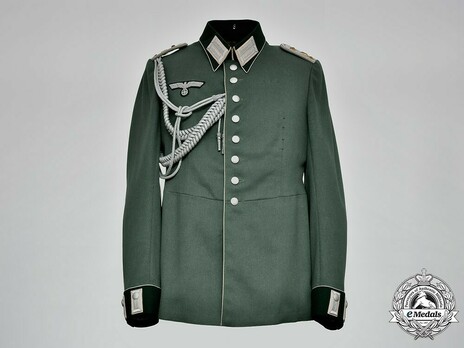
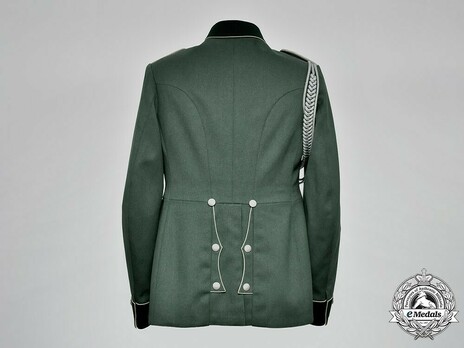
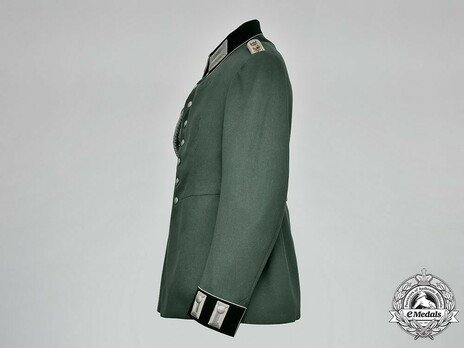
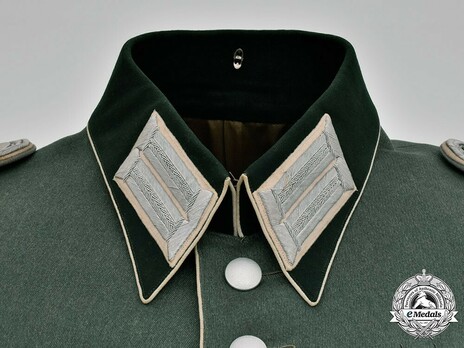
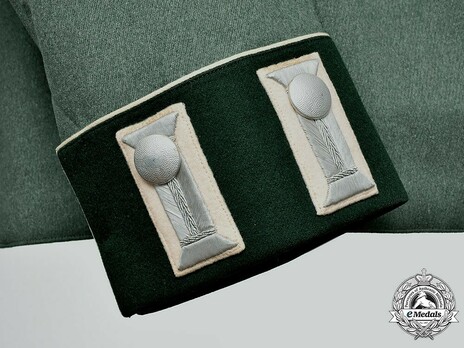
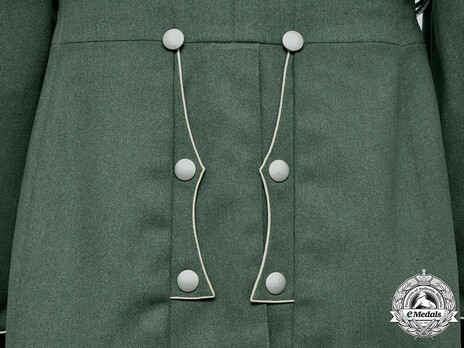
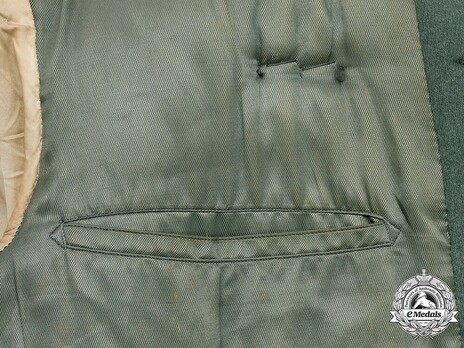
Estimated market value:
Heer (Army) Reserve officer’s dress tunic constructed of a smooth field-gray wool exterior with an intact rayon-blended interior liner. The collar, constructed of smooth hunter green wool, is neatly lined from end-to-end with the white “Waffenfarbe” (corps colour) piping of Wehrmacht infantry personnel. The collar is flanked on each side by tabs, constructed of a white wool base bearing the two machine-embroidered silver aluminum bullion wire columns of infantry officers, measuring 73 mm (w) x 44 mm (h). The shoulders are flanked by shoulder boards constructed of grey and white wool layers upon which four silver aluminum bullion wire thread braids are stitched and looped through a pebbled magnetic metal button securing the boards to the tunic. The tops of the boards each display the two brass rank pips of a Hauptmann (Captain), while a brass “18” pinned through the centre of each boards indicates the 18th Infantry Division. The cuffs of each sleeve are constructed of hunter green wool, turned up to a depth of 76 mm and securely stitched in place around the circumference. Each cuff bears two Hauptmann rank insignia patches of a white wool base with a silver aluminum bullion wire column and pebbled magnetic metal button, measuring 60 mm (h) x 31 mm (w). The top right breast displays a machine-embroidered silver aluminum bullion wire Wehrmacht-style German national eagle clutching a wreathed mobile swastika, measuring 102 mm (w) x 43 mm (h). The left breast has three vertical thread loops, arranged horizontally, and four horizontal thread loops, arranged vertically, to accommodate decorations with horizontal and vertical pinbacks, respectively. The right breast flap has eight pebbled magnetic metal buttons meeting an equal number of reinforced buttonholes on the left flap. All buttons are stamped “EXTRA FEIN” on the reverse. Suspended from the right shoulder board is a well preserved Wehrmacht aiguillette constructed of silver aluminum bullion wire divided into two sections, with one braided into two rows and completing at the ends with thread attachment loop around a brown bakelite button on the right breast of the tunic, while the other presents as a narrow woven rope looped through their braided counterparts, ending with stylized zinc tips. The bottom of the reverse has a vertical slit flanked by stylized, white-piped flaps, each held in place by three pebbled magnetic metal buttons. The interior liner is composed of a green rayon-blended material with a silky-smooth finish, met at the arms by an off-white liner of similar composition and quality. There is an interior belt apparatus stitched into the liner, composed of two ribbons of liner fabric, each 100 mm in length, meeting with polished magnetic metal clips that fit securely into place. There is a single interior pocket at the top left breast, opening with a reinforced vertical slit. Each armpit has a woven rayon-blended loop for suspension of a dagger. The right collar interior has two brass hooks set into the material meeting an equal number of brass loops on the right to ensure a flush fit with the wearer’s neck. The tunic is unmarked, and measures approximately 485 mm across the shoulders, with an arm length of 680 mm and an overall body length of 760 mm. While there is minor soiling of the exterior right breast and interior liner, as well as minor fatigue to the wool of the collar and cuffs, the tunic presents in an otherwise extremely fine condition.
The Dress Tunic was introduced on June 29, 1935. It was worn by all members of the Heer during parades and ceremonial occasions, and as a walking-out dress.
The tunic is field-grey with a dark blue-green collar and dark blue-green cuff-facings, and has branch colour piping down the edge of the front overlap, down the front edge of the collar and around the collar base, on the upper edges of the cuff-facings, and down the two tunic flaps in the back.
The collar has a stand-up and fall-down part. There are eight silver-white metal buttons down the front. Three more buttons are attached to each of the two tunic flaps on the back, and one non-functional button to each of the four cuff-facing patches. General ranks had gold-coloured buttons.
The tunic has no pockets, except for two hidden pockets in the tunic tail.
Tunics for higher ranked soldiers are generally made from materials of superior quality. There are four different rank segments wearing slightly but distinctively different tunics: EMs (enlisted men), NCOs (non-commissioned officers), officers, and generals. General rank tunics can be identified not only by the gilt buttons, but also the ornate gilt embroideries on their cuff and collar patches. All other ranks had so-called Litzen (flat braid) on their cuff and collar patches. Those of officers were made of superior quality material and are more elaborate in design compared to the rather plain ones of EMs and NCOs. The difference between EM and NCO tunics lies in another type of flat braid, so-called Tresse (trimming), along the edges of the cuffs and collars, similar to those on NCO rank shoulder straps.
Tunic insignia, such as breast eagles, collar tabs, or shoulder boards will differ from rank to rank. For more information, see the appropriate entries in the Insignia subcategory.
Production of the dress tunic was discontinued with the outbreak of the war.
A special version was introduced on September 15, 1939 for members of the Infantry Regiment “Großdeutschland”. It has white piping and white metal buttons. The collar Litzen are elongated. Officer tunics have two collar Litzen, while those for EMs and NCOs only have one. There are three cuff-patches per cuff, which are of the so-called “French” cuff patterns.
Only very few jackets were ever given out due to the outbreak of the war, and it was never manufactured in great numbers.
Chaplains wore an Überrock (frock coat) in place of the Dress Tunic. For more information, see the Coats subcategory.
Branch colours on German Heer headgear was as follows:
Black was worn by Engineer units.
Black/White was worn by Panzer Engineers.
Copper Brown was worn by Motorcycle personnel.
Light Brown was worn by Signals units until 1936, and by Construction troops.
Carmine was worn by the Führer Staff, General Staff Officers, Staff Officers of the Supreme Command of the Army, and all Veterinary branches.
Bordeaux Red was worn by Smoke & Chemical personnel.
Wine Red was worn by Judicial officials.
Bright Red was worn by Generals, Artillery units, and Ordnance Officers (until 1944).
Rose or Pink was worn by all Armored units (including Panzer troops, and Schützen Brigade Staff).
Orange was worn by Recruiting personnel, Ordnance troops, Ordnance Officers (since 1944), and Field Gendarmerie units.
Bright yellow was worn by Cavalry units, and Light Division Staff.
Lemon yellow was worn by Signal units.
White was worn by Infantry units.
Light Grey was worn by Propaganda personnel.
Grey-Blue was worn by Sonderführer (Specialist Officers).
Violet was worn by Chaplains and Field Bishops.
Cornflower Blue was worn by Medical units, and Supply units.
Bright Blue was worn by Transport troops.
Bright Green was worn by Jäger and Mountain units.
Grass Green was worn by Panzer Grenadier units (Armored Infantry).
Dark Green was worn by Administrative personnel.

Comments
Sign in to comment and reply.


Scroll Top